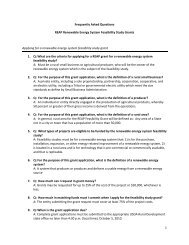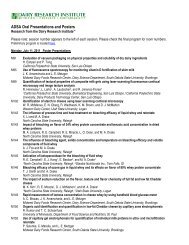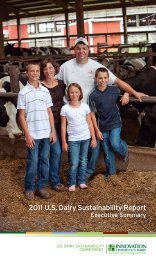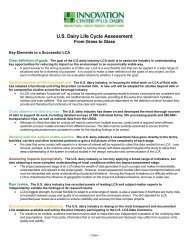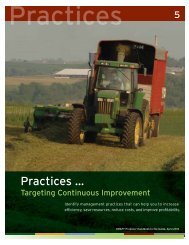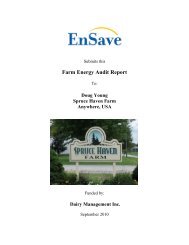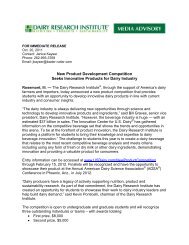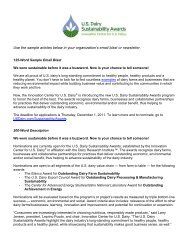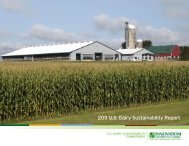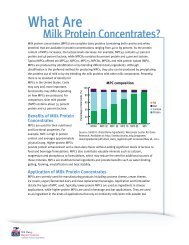Processor Handbook - Innovation Center for US Dairy
Processor Handbook - Innovation Center for US Dairy
Processor Handbook - Innovation Center for US Dairy
Create successful ePaper yourself
Turn your PDF publications into a flip-book with our unique Google optimized e-Paper software.
3.2 Report the total number of employees and consultants<br />
hired by type of category if applicable (full-time or<br />
part-time).<br />
Report the numbers per category by using the Employee<br />
Hired Table (page 34).<br />
4. Optional measurement considerations<br />
None<br />
5. Definitions<br />
Employee: An employee is any person of legal working age<br />
who receives a salary or wages.<br />
Full-time: The Fair Labor Standards Act (FLSA) does not<br />
define full-time employment or part-time employment. This<br />
is a matter generally to be determined by the employer.<br />
To apply a consistent definition <strong>for</strong> the purpose of<br />
measurement, a full-time employee is anyone who works 40<br />
hours a week or more.<br />
Part-time: The FLSA does not define full-time employment<br />
or part-time employment. This is a matter generally to be<br />
determined by the employer. To apply a consistent definition<br />
<strong>for</strong> the purpose of measurement, a part-time employee is<br />
anyone who works less than 40 hours a week or more.<br />
Consultant: The FLSA does not define consultant. For<br />
the purpose of measurement, a consultant is someone<br />
employed externally, either by a firm or self-employed,<br />
whose expertise is provided on a temporary basis <strong>for</strong> a fee.<br />
6. Documentation<br />
In<strong>for</strong>mation on employee numbers and salary can typically<br />
be obtained from a processing and/or manufacturer’s<br />
human resources department and payroll.<br />
7. Resources<br />
• Economic Research Service. U.S. Department<br />
of Agriculture. May 2010. Local Food Systems:<br />
Concepts, Impacts and Issues. www.ers.usda.gov/<br />
Publications/ERR97/ERR97_ReportSummary.pdf.<br />
• Land Stewardship Project. 2009. Multiple Benefits<br />
of Agriculture and Pasture-Raised Livestock. www.<br />
landstewardshipproject.org/programs_mba.html<br />
Employee Benefits —<br />
Primary PM Employees 2<br />
1. Relevance<br />
Reporting employee benefits provides a measure of<br />
the company’s investment in human resources and the<br />
minimum benefits it offers to its full-time employees.<br />
The quality of benefits <strong>for</strong> full-time staff is a key factor<br />
in retaining employees. Employee benefits can be both<br />
indirect and non-monetary compensation and include<br />
health insurance, retirement plans, housing, processed<br />
products, use of company vehicles employee discounts,<br />
to name a few. Employee benefits also helps to maintain<br />
employee morale and productivity. 20<br />
2. Metric<br />
Number of indirect and non-monetary benefits received<br />
by employees<br />
3. Calculation and reporting<br />
3.1 Identify and report benefits offered to all employees.<br />
3.2 Report benefits received by full-time or part-time<br />
employees by using the Employee Benefits Table.<br />
4. Other measurement considerations<br />
None<br />
5. Definitions<br />
Employee: An employee is any person of legal working<br />
age who receives a salary or wages<br />
Full-time: The FLSA does not define full-time employment<br />
or part-time employment. This is a matter generally to<br />
be determined by the employer. To apply a consistent<br />
definition <strong>for</strong> the purpose of measurement, a full-time<br />
employee is anyone who works 40 hours a week or more.<br />
Part-time: The FLSA does not define full-time employment<br />
or part-time employment. This is a matter generally to be<br />
determined by the employer. To apply a consistent definition<br />
<strong>for</strong> the purpose of measurement, a part-time employee is<br />
anyone who works less than 40 hours a week or more.<br />
4<br />
Employee Benefits<br />
Number of<br />
Full-Time<br />
Employees<br />
Receiving this<br />
Benefit<br />
Number of<br />
Part-Time<br />
Employees<br />
Receiving this<br />
Benefit<br />
Total Number<br />
of Employees<br />
(include<br />
both full-and<br />
part-time<br />
employees)<br />
Health insurance without employer<br />
contribution<br />
Health insurance with employer contribution<br />
401k (or comparable retirement plan)<br />
Housing<br />
Produced/Processed products (milk/produce)<br />
Use of company vehicles<br />
35<br />
continued on page 36





